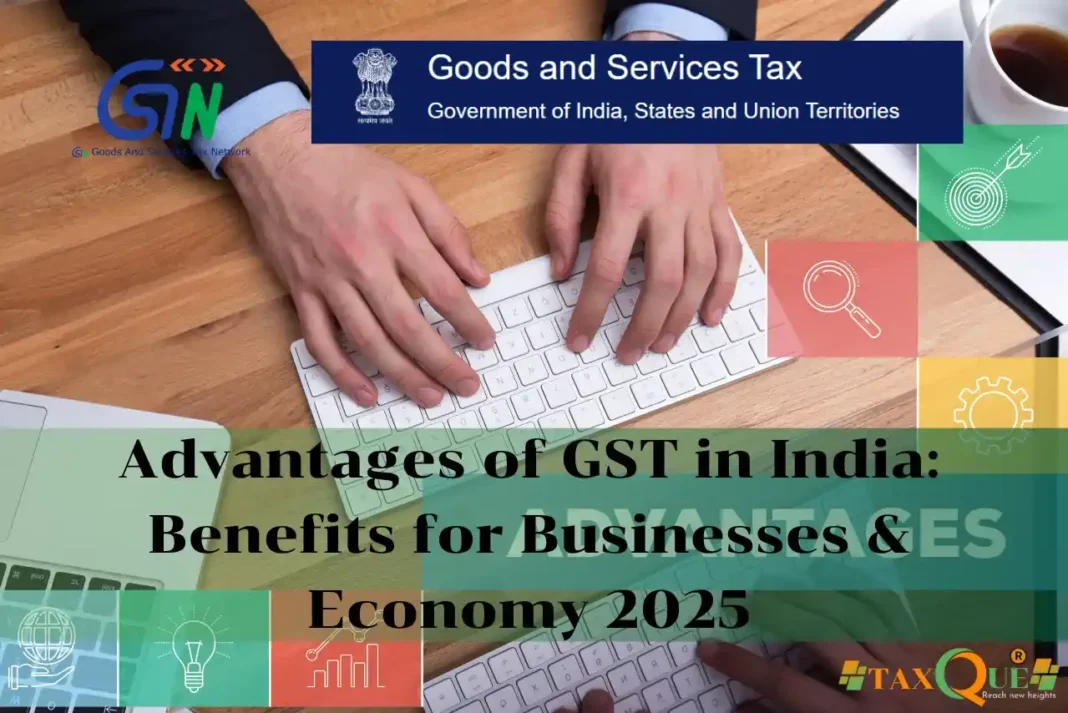Introduction
The advantages of GST in India have transformed the country’s taxation landscape since its implementation on July 1, 2017, under the Goods and Services Tax (GST) regime. By replacing a complex array of indirect taxes with a unified system, GST has streamlined compliance and boosted economic efficiency for businesses in cities like Patna, Bangalore, and Hyderabad. This blog explores the advantages of GST, highlighting benefits for businesses, consumers, and the economy as of June 3, 2025, and explains how TaxQue simplifies GST compliance for companies navigating registration and operations.
What Are the Advantages of GST?
The advantages of GST stem from its design as a destination-based, multi-stage tax on goods and services, administered by the GST Council. GST unifies central and state taxes (e.g., excise duty, VAT, service tax) into a single framework, using state codes (e.g., 10 for Bihar, 29 for Karnataka) in the GSTIN. These benefits enhance transparency, reduce tax burdens, and support economic growth, making GST a cornerstone for businesses during company registration and operations.
Key Advantages of GST for Businesses
The advantages of GST significantly impact businesses across India:
Elimination of Tax Cascading
- Benefit: GST allows input tax credit (ITC) at each supply stage, reducing tax-on-tax. For example, a Bangalore manufacturer buying raw materials can claim ITC, lowering costs for products like mobiles (18% GST).
- Impact: Reduces production costs, enabling competitive pricing for SMEs in Patna or Hyderabad.
Simplified Compliance
- Benefit: Single GST registration with a GSTIN (e.g., 29 for Karnataka) replaces multiple tax registrations. The GSTN portal streamlines filing GSTR-1 and GSTR-3B, reducing paperwork.
- Impact: Eases compliance for businesses during company registration, saving time and resources.
Unified National Market
- Benefit: Removes inter-state tax barriers, enabling seamless goods movement (e.g., from Bihar to Karnataka). E-way bills with state codes simplify logistics.
- Impact: Expands market access for businesses, boosting sales and scalability.
Reduced Compliance Costs
- Benefit: Digital tools like e-invoicing and GSTN reduce manual processes, with state-specific jurisdictions (verifiable on CBIC portal) simplifying audits.
- Impact: Lowers administrative costs for retailers selling laptops or TVs (18–28% GST).
Advantages of GST for Consumers
Consumers also reap the advantages of GST:
- Transparent Pricing: GST rates (e.g., 18% on mobiles, 28% on large TVs) are uniform nationwide, visible on invoices, reducing hidden taxes.
- Lower Prices: ITC benefits pass cost savings to consumers, e.g., a ₹20,000 smartphone incurs ₹3,600 GST, not higher pre-GST taxes (~12–31%).
- Wider Choices: A unified market increases product availability, benefiting consumers in Patna or Bangalore with access to diverse electronics.
Advantages of GST for the Economy
The advantages of GST extend to India’s economy:
- Increased Tax Revenue: GST collections reached ~₹1.5 lakh crore monthly by 2025, supporting infrastructure and welfare programs.
- Economic Growth: A unified market and lower logistics costs boost GDP, with GST contributing to a 7%+ growth rate in 2025.
- Formalization: Mandatory GST registration for businesses above ₹20 lakh (services) or ₹40 lakh (goods) encourages formal economy participation, reducing black money.
- Global Competitiveness: Simplified taxation attracts FDI, strengthening India’s position as a manufacturing hub for electronics.
GST Compliance and Company Registration
The advantages of GST integrate with company registration:
- GST Registration: Required post-incorporation for businesses in Patna or Bangalore with turnover above thresholds, using state codes (e.g., 10 for Bihar).
- GSTIN: 15-digit code (state code + PAN + entity code) assigned via the GST portal, enabling ITC claims.
- Returns: File GSTR-1 (sales) and GSTR-3B (summary) monthly/quarterly, ensuring HSN codes (e.g., 8517 for mobiles) are correct.
- Penalties: ₹10,000–₹25,000 for non-compliance (e.g., incorrect GSTIN or late filings).
- Use TaxQue for seamless compliance management.
TaxQue maximizes the advantages of GST with expert support for GST registration, return filing, and company setup. Visit TaxQue’s GST compliance guide or company registration services for efficient solutions.
FAQs
1. What is a key advantage of GST for businesses?
Elimination of tax cascading through ITC reduces costs, a major advantage of GST.
2. How does GST benefit consumers?
Uniform rates and ITC lower prices, e.g., 18% GST on laptops versus higher pre-GST taxes.
3. How does GST support India’s economy?
GST boosts revenue (~₹1.5 lakh crore monthly in 2025) and formalizes the economy.
4. Is GST compliance complex for new businesses?
GSTN and digital tools simplify compliance, though SMEs may need support like TaxQue.
5. How does TaxQue enhance the advantages of GST?
TaxQue offers tools for GSTIN verification, invoicing, and return filing. Explore TaxQue’s compliance services.
Conclusion
The advantages of GST in India have revolutionized taxation since 2017, offering businesses cost savings, simplified compliance, and market access, while benefiting consumers with transparent pricing and the economy with growth. From Patna to Bangalore, GST’s unified system supports seamless operations during company registration and beyond. Platforms like TaxQue amplify the advantages of GST with expert tools for compliance and registration. Embrace GST’s benefits, stay compliant, and thrive in India’s dynamic market in 2025.





